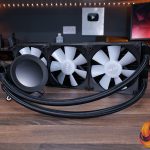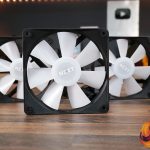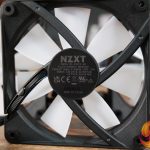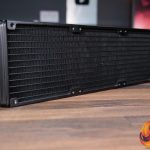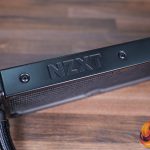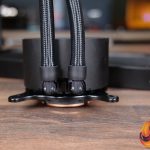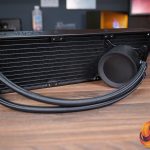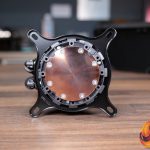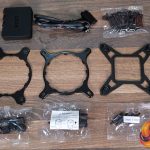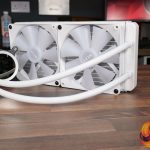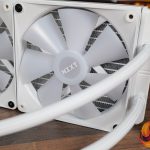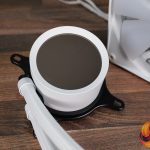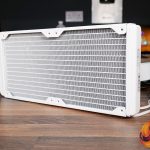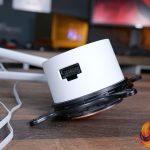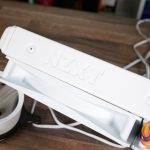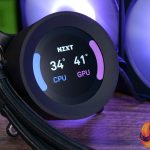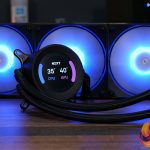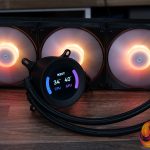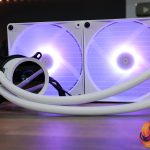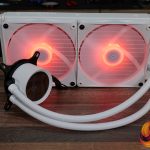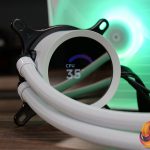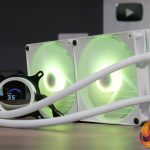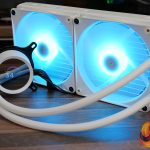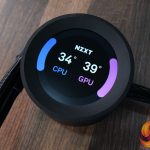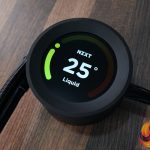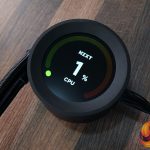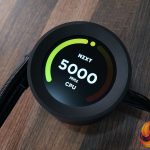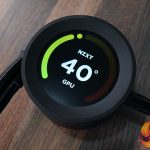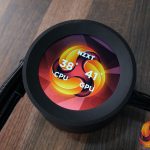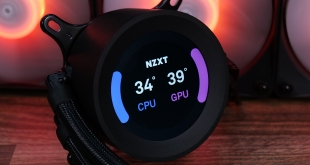
Over the past couple of weeks, we have been updating the CPU cooler test bench from the previous Ryzen 9 5950X system to a new AM5 X670 Aorus Elite motherboard and Ryzen 9 7950X CPU. We are also adding an Intel Z790-based test system to compare cooler performance on both platforms, and that will be coming soon. The first coolers to be reviewed on the 7950X test system are new NZXT Kraken AIOs. These new liquid coolers come in various shapes and sizes and we have both the Kraken 280 RGB and Kraken Elite 360 RGB. But will they handle the heat of the 7950X? Let's find out.
Timestamps:
00:00 Start
01:10 Details and pricing / Displays
04:37 Tech details / fans
05:48 Some features
07:00 Warranty and more fan details
07:42 Two samples / connectors and cables
11:47 Installation process / Cam software
15:29 Performance results
17:47 Closing thoughts
NZXT has launched new Kraken AIO CPU coolers with a whole stack of SKUs to choose from. The previous Kraken X and Z series are set to be replaced with new Kraken and Kraken Elite models, available with or without RGB fans and in either black or white colour schemes. The new coolers are still based on Asetek generation 7 platforms however the Kraken’s all come with LCD screens now and newly designed F120/F140 Core RGB fans.
Because the coolers are designed around the Asetek gen 7 pump/radiator design we don’t expect any improvement in performance to come from these parts, however, new fans may squeeze a little more cooling performance out of the gen 7 platform so it’ll be interesting to see how they perform. Besides the new fans, NZXT has also added an LCD screen on the CPU block top of both the new Kraken and Kraken Elite.
The only difference between Kraken and Kraken Elite is the LCD screen, the flagship Elite model has the higher spec display screen out of two with a 2.36-inch wide-angle LCD, 640×640 resolution and 60 Hz refresh rate. The cheaper Kraken (non-elite) features a 1.54-inch square LCD with 240×240 resolution and 30Hz refresh rate, significantly reducing the Kraken cost compared with the Kraken Elite.
You can also buy them in black or white, with or without RGB fans and in 240mm, 280mm and 360mm sizes. The non-elite Kraken with regular black or white non-RGB fans starts from £119.99 while the most expensive is the top-of-the-range Kraken Elite 360 RGB which will set you back a cool £259.99, so there’s an LCD-clad cooler for almost every price range. The Infinity mirror design from the previous Kraken X series has gone.
NZXT Kraken and Kraken Elite features:
- Both the Kraken and Kraken Elite are available in black and white, with RGB or regular non-RGB fans in 240mm (2 x 120mm fans), 280mm (2 x 140mm fans) and 360mm (3 x 120mm fans) with differing LCD displays mounted on top of the CPU block/Pump unit.
- Kraken and Kraken Elite are both based on an Asetek generation 7 platform with a 27mm thick aluminium radiator, a solid copper cold plate with micro-skived fins and a powerful pump motor with a speed of up to 2800RPM
- The coolers are equipped with NZXT F series static pressure and Core RGB fans that feature full PWM control with a speed range of 500-1800 RPM (F120 120mm) controlled via NZXT CAM with a Zero RPM mode for silent operation.
- NZXT Kraken coolers support all current desktop CPU sockets from Intel including LGA 1700, 1200 and 115X and AMD AM4/AM5 sockets plus some high-end desktop platforms such as AMD Threadripper (bracket available separately).
- The tubing Length of 400mm is manufactured from a low evaporation rubber with a high-quality nylon braided sleeving and 90-degree articulating fittings at the CPU block side to aid installation.
- On the Kraken display users can show system information, web integrations such as Google Photos or showcase custom images while exclusively to the Kraken Elite LCD display are custom or GIPHY GIFs, GIFs with a system overlay on top and an audio visualiser that reacts to audio input in real-time as well as system information.
Kraken Elite 360 RGB Specifications:
- CPU Compatibility: Intel LGA 1700, 1200/115X, AMD Socket AM5, AM4, sTRX4, TR4 (Threadripper bracket not included)
- Water Block Material: Copper (block), Plastic (housing)
- Pump Motor Speed: 800 – 2,800 ± 300 RPM
- Pump Power: 12V DC, 0.3A
- Radiator Dimensions: 121 x 394 x 27mm
- Radiator Material: Aluminium
- Tube Length: 400mm
- Tube Material: Ultra-low Evaporation Rubber with Nylon Braided Sleeve
- Fan Model: F120 RGB Core Fans
- Fan Speed: 500-1,800 ± 180 RPM
- Fan Airflow: 86 CFM
- Fan Air Pressure: 57 mm H2O
- Fan Noise: 88 dBA
- Fan Bearing: Fluid Dynamic Bearing
- Fan Connector: 4-pin PWM
- Display Orientation: Software adjustable Default, +90, +180, and -90 Degrees
- Display Panel Active Area: 36” (60mm) diameter
- Display Resolution: 640 x 640 px
- Display Brightness: 690 cd/m²
- Display Colour: 24-bit true colour LCD
- Warranty: 6 Years
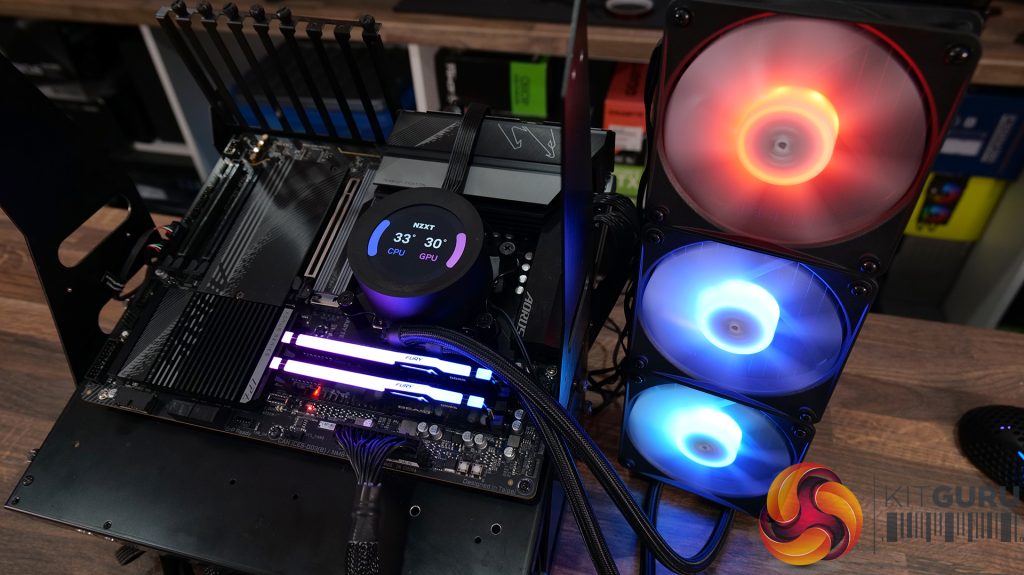
Test System Specifications:
- CPU: AMD Ryzen 9 7950X
- Motherboard: Gigabyte X670 Aorus Elite AX
- Memory: 32GB Kingston Fury FK560C36BBEAK2-32 DDR5-6000
- Graphics card: Gigabyte RX 6700 XT Gaming OC
- Storage: 500GB Corsair MP600 PCIe Gen4 NVME M.2 SSD
- Power Supply: Seasonic Prime TX-1000
- Chassis: Open Test Bench
- Thermal Compound: Arctic MX-6
- O/S: Windows 11 Version 22H2
Testing Methodology:
We are primarily focussing on the performance of each cooler at 100% fan speed and also when locked to 40dBA noise output. We will focus on cooling performance using a manual overclock with all-core frequency and VCORE locked to 5.2GHz/1.3v and Precision Boost Overdrive performance.
- The test data is logged using HWINFO and the final 10 minutes of the data is calculated to find the average CPU temperature and CPU clock multiplier (PBO Test) and then plotted in the charts.
- For testing, we use a 30-minute looped run of Cinebench R23 and record the steady-state CPU temperature at the end of the test. This ensures that the CPU has had ample time to warm up and reach a steady state under all of the coolers.
- The ambient is maintained at 19-21 degrees Celsius. Where there is variation beyond this temperature range, we add extra repeated tests to ensure consistency. However, this is well controlled now with A/C.
- We also test each cooler with at least two fresh installs (typically three) to mitigate the likelihood of poor mounting spoiling results.
- Ambient temperature and humidity are controlled via a mini split air conditioning system inside the test room. Ambient temperature is maintained between 19-21C, Temperature delta figures are shown in the charts (ambient temperature is deducted from the measured component temperature).
Test Results:
Acoustics
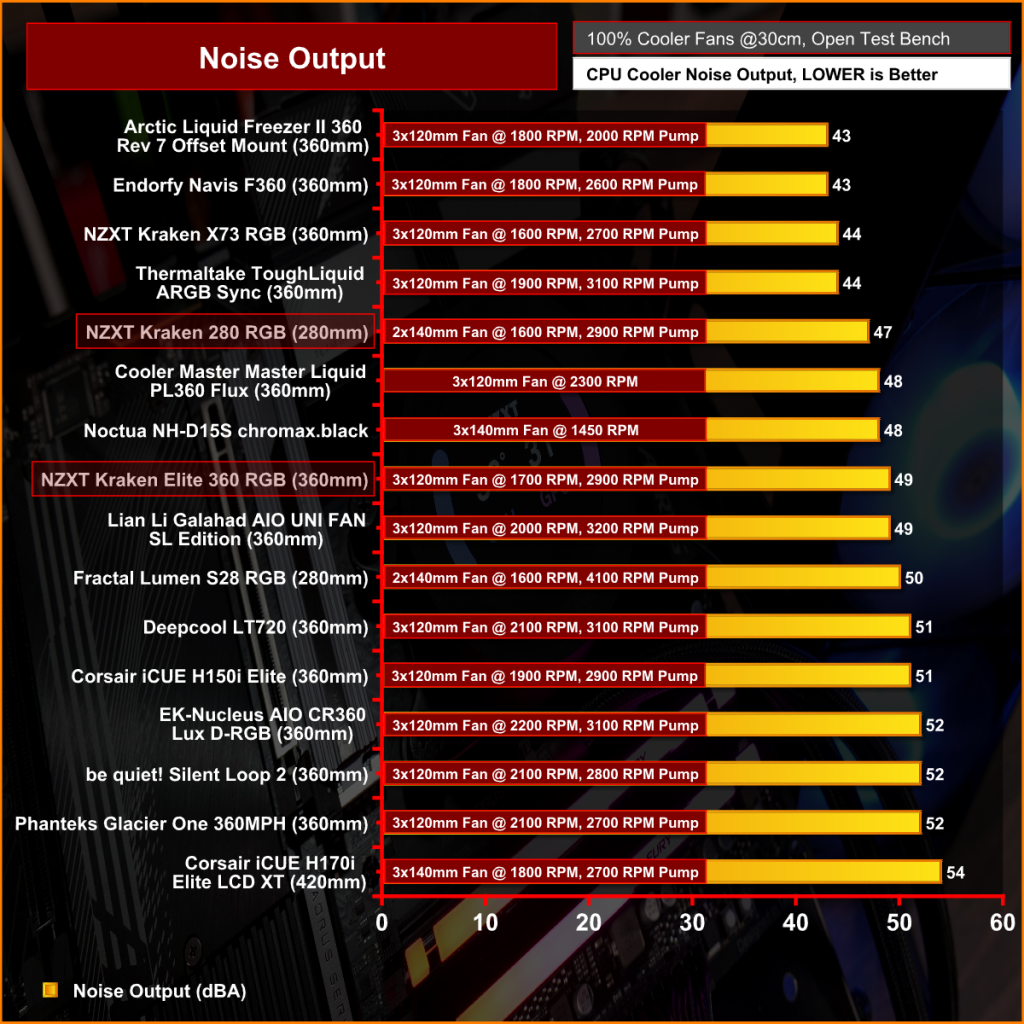
Let’s start by looking at noise output as this will give us a good indication of performance based on noise.
With the fans running at maximum RPM the Kraken Elite 360 isn’t the loudest cooler but at 49dBA the noise is very noticeable over ambient noise, with two fans running at lower RPM the Kraken 280 is 2dBA quieter which doesn’t sound like much but there’s quite a difference in noise output between the two coolers.
Thermal Performance
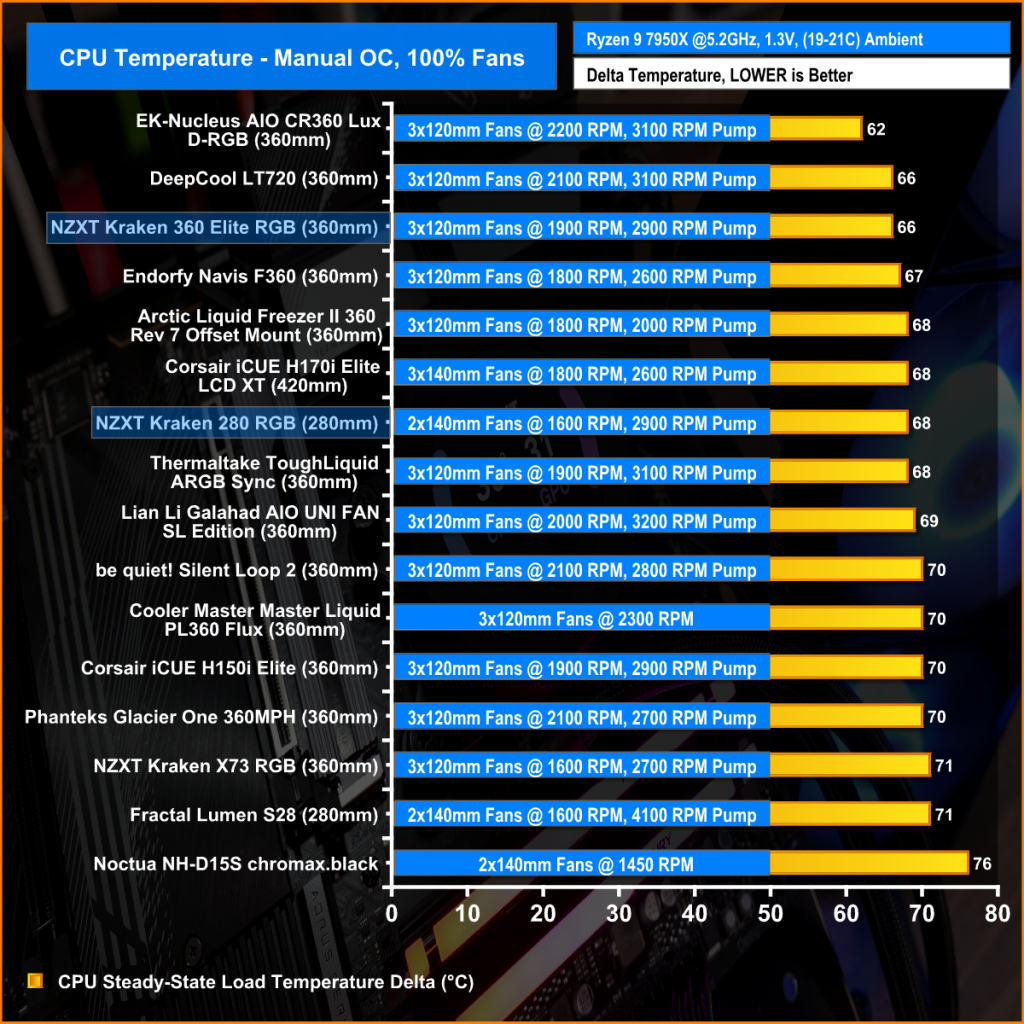
Sticking with fans at maximum RPM, in this configuration the Kraken Elite 360 performs very well, keeping the 7950X average delta temperature at 66°C which places the Kraken Elite 360 in the top three of our chart, the Kraken 280 isn’t far behind either with an average CPU temperature delta of 68°C.
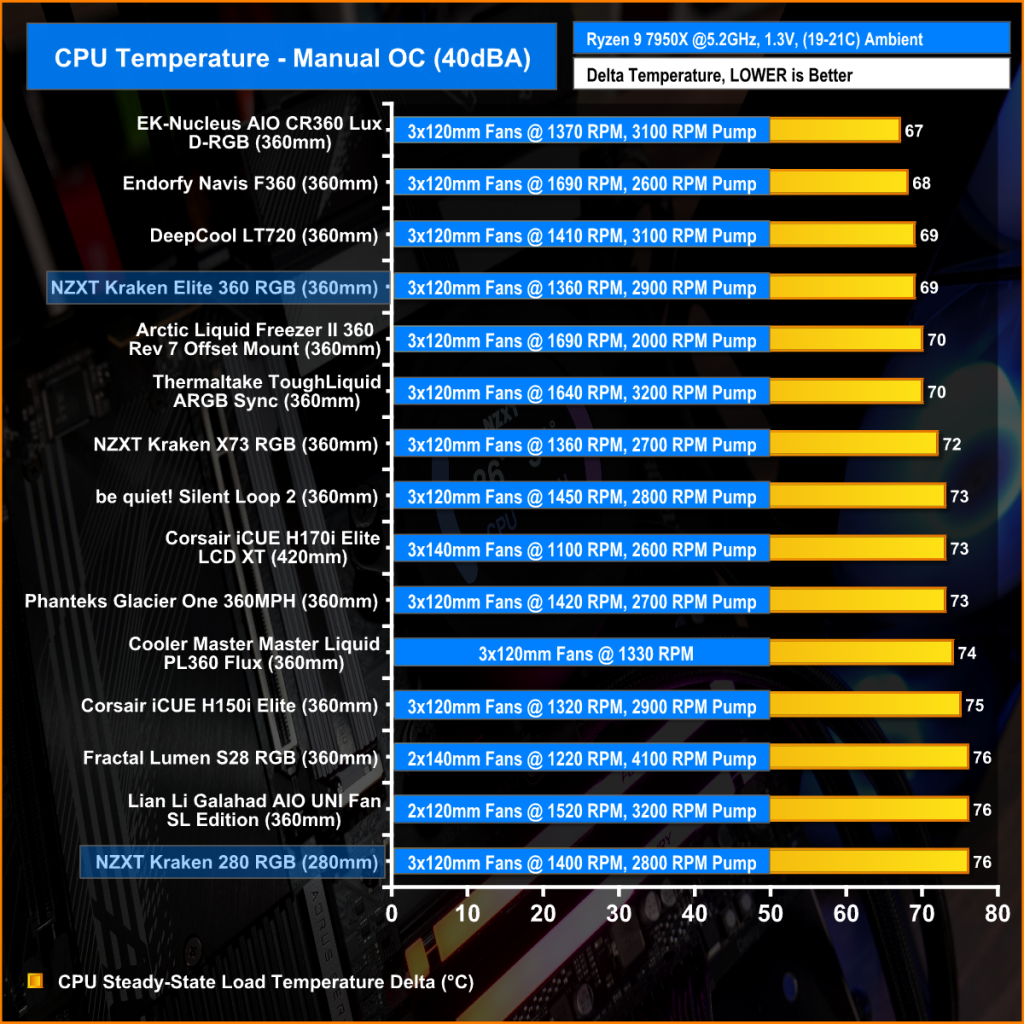
Normalising noise output to 40dBA the Elite 360 is still trading blows with the top coolers that we have tested showing that it has genuinely good thermal performance which is no great surprise as the old Krakens also performed well, and the new F120 fans are doing a good job. However, the Kraken 280 performance tails off with noise normalised which is a little disappointing but is expected of a 280mm unit on this CPU as you can see from the results of the other 280mm AIO that we tested.
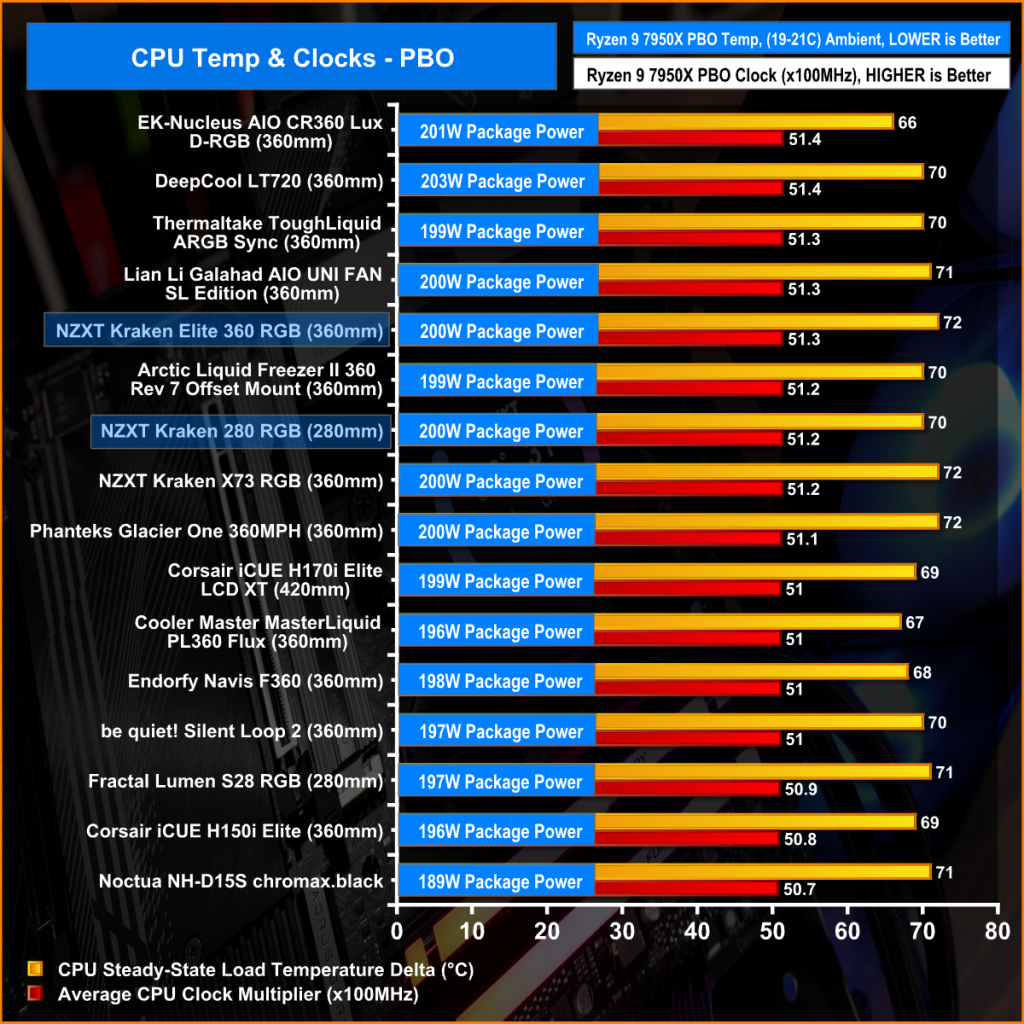
In the PBO test, the difference between CPU delta temperature is small, so the important metrics here are clock speed and cooling power.
The Kraken Elite 360 again performs well holding on to an average clock multiplier of 51.3X at 72°C while handling an average package power of 200W. The 280mm unit isn’t far off with an average 51.2x clock multiplier and also 200W package power which is a good performance from both coolers.
For NZXT enthusiasts looking to upgrade their current all-in-one liquid CPU coolers, the new Kraken and Kraken Elite might seem like an ideal option. If you are building a completely new system from scratch with an NZXT theme then yes, it would make sense to use one of the new Kraken and Kraken Elite coolers. Depending on system specs and the budget you have NZXT has you covered with Kraken and Kraken Elite spanning a wide price range and a good selection of configurations.
However, if you are thinking of picking up one of these new coolers to upgrade or replace your current NZXT X3 or Z3 AIO then it might be worth thinking again. If you currently own the previous Kraken X3 with the infinity mirror design and absolutely need an LCD screen on your cooler then the Kraken non-Elite would be a sensible upgrade choice that would not bust your wallet. If you want to splash the cash then the Elite is also an option.
But if you own the previous Kraken Z3 which already has an LCD screen then neither of these coolers are worth upgrading to as the Kraken Elite is virtually identical to the old Z3 range, so save your cash and spend it elsewhere. If you prefer the look of the new F120 RGB fans, you would be better off just buying those separately and fitting them to your Kraken Z3, but to be honest I prefer the old RGB fans that came with Kraken X3 and Z3, they look better quality.
Don’t get me wrong, I’m not knocking the new Kraken and Kraken Elite at all, they might be a tad expensive but which AIOs with LCD screens aren’t? NZXT seems to have priced them competitively compared with competition from the likes of Corsair, EKWB and Thermaltake etc. Performance seems on point, especially with fans at maximum RPM and they are not excessively loud, but they do have some negative points.
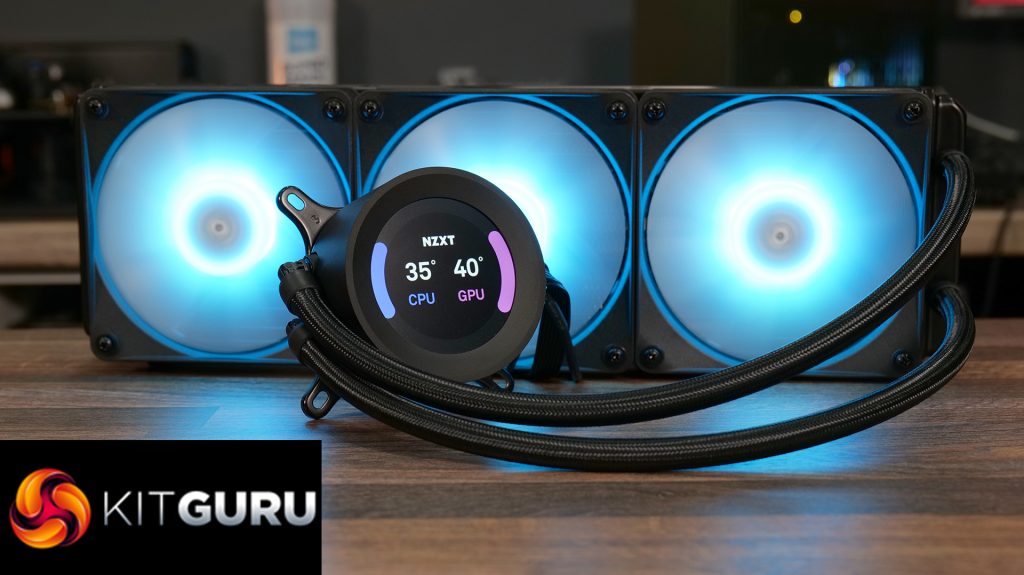
The RGB lighting effects are OK and swapping between RGB effects is pretty easy using the NZXT CAM software. The implementation of the RGB lighting is the problem – there is a noticeable light bleed from the individual LEDs on the hub of the fan which is a shame, the LEDs need better diffusion or need to be spaced differently to overcome this. That's another reason why I prefer the old RGB fans that come with the previous Kraken RGB coolers.
There’s also still a lot of wiring to manage. NZXT has changed the connection so there’s just one cable coming from the CPU block, but it splits into multiple cables and an RGB controller has been added which means you need more SATA power connections and there’s more cables to manage overall. So even though it might look slightly neater around the CPU block, there’s more cables to hide and managed around the back of your system.
NZXT stuck with Asetek generation 7 as the base for the new Kraken and Kraken Elite coolers which seems to have paid off as the gen 7 pump is very quiet, running at maximum RPM the pump noise is virtually silent when inside a chassis with the side panel installed which is great. Thermal performance on our new AMD Ryzen 9 7950X test bench is very good also which shows that the new F series fans help with cooling even if the RGB lighting doesn’t look perfect, which is good news in this day and age with CPU power consumption and heat as it is.
Taken as a whole the NZXT Kraken and Kraken Elite are good coolers, when it comes to thermals they produced solid performance and both LCD screens look very nice, the Elite LCD is by far superior but the non-elite provides a good budget LCD screen solution. If I was building an NZXT-specific theme system then I would buy one, but if you are not too concerned about looks or LCD screens there are much cheaper alternatives out there that perform just as well when it comes to cooling high-end CPUs.
You can purchase the NZXT Kraken 360 Elite now from Overclockers UK priced at £259.99 HERE. The NZXT Kraken 280 is also available at Overclockers UK priced at £169.99 HERE.
Discuss on our Facebook page HERE.
Pros:
- Good-looking coolers.
- Performance improvement over previous Kraken AIOs.
- LCD displays on all versions look good.
- RGB and Non-RGB options are available.
- Choice of black or White.
- There's one to suit all budgets
Cons:
- Still lots of wiring to manage.
- New fans look a little cheap compared to previous fans.
- Individual LED light bleed from the fan hubs.
- Some black cables with white coolers look out of place.
KitGuru says: If you want a shiny new NZXT cooler with an LCD screen to match your NZXT-themed PC, then by all means go out and buy one of these new Kraken and Kraken Elite AIOs. If you don’t care about looks but need solid performance, it might be worth checking out some of the other coolers we have reviewed as there are some real bargains out there to be had.
 KitGuru KitGuru.net – Tech News | Hardware News | Hardware Reviews | IOS | Mobile | Gaming | Graphics Cards
KitGuru KitGuru.net – Tech News | Hardware News | Hardware Reviews | IOS | Mobile | Gaming | Graphics Cards


